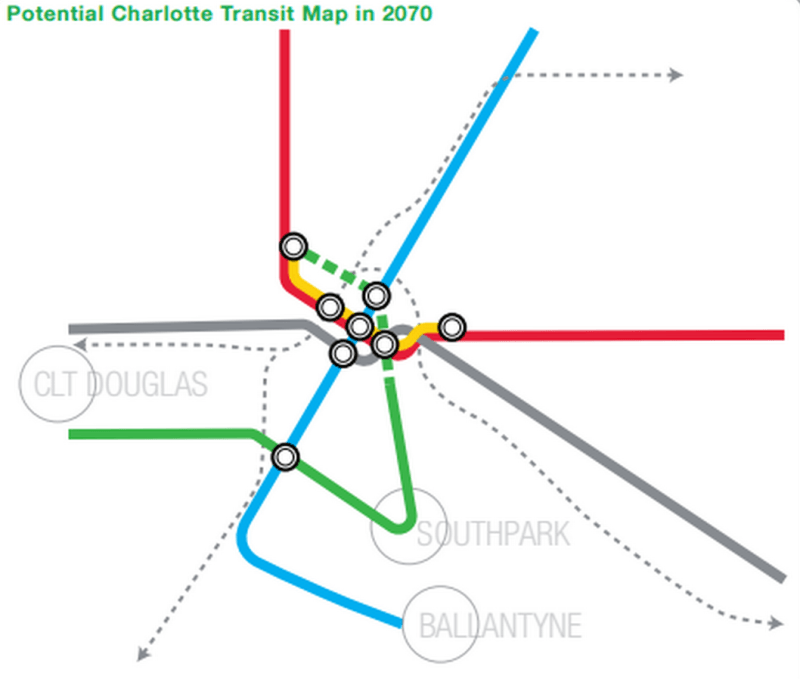Kimley-Horn, a multinational consulting firm looking to plan the next phases of the Charlotte area's rail expansion, also has ideas for new rail lines above and beyond the region's long-term blueprint -- projects that would be designed and built, naturally, by multinational consulting firms like Kimley-Horn. Trouble is, the firm's fantasy exercise does nothing to address the real challenges facing Charlotte's transit network.
Earlier this year, the Charlotte Area Transit System issued an RFP looking for consulting firms help it figure out three big challenges: how to bring rail service north to Lake Norman, how to bring rail west to the airport, and how to knit together the growing rail system downtown [PDF].
In addition to submitting bids answering those questions, one consultant graciously offered ideas for how the transit agency could send more money its way. Steve Harrison at the Charlotte Observer reports:
One firm, Kimley-Horn, also suggested that it study future transit corridors that could be built after the initial $6 billion in new rail lines are built.
Kimley-Horn suggested CATS consider reserving right-of-way for extending the Blue Line to Ballantyne; building a new rail line to SouthPark; and extending a commuter rail line to east Charlotte. Those lines could be part of a 2070 plan, the consultant said.
“There are still areas of the city that are developing outside of the defined growth corridors,” Kinmley-Horn said in its presentation. “The SouthPark area is a prime example. SouthPark has seen rapid expansion and development as a retail, office and residential center. This could very well be a center that the city will want to connect to Center City with rail transit.”
Charlotte transit advocates are skeptical. “We need to be building transit to the west and to the north first, per the plan we’ve had for over a decade,” said Shannon Binns, executive director of Sustain Charlotte. “It did strike me as a little bit odd that consultants were suggesting lines that weren’t even part of this RFP.”
In addition to Kimley-Horn, mega-consultants WSP/Parsons Brinckerhoff, HNTB, and STV submitted proposals to CATS, the Observer reports. All four have done previous work in Charlotte.
Binns said transportation projects in Charlotte, like in many places, are heavily reliant on consultants, and their incentives don't necessarily align with the public interest. “If they are the ones creating the plan, and they make the plan ambitious and expensive enough, they stand to make more money down the road when they build it," Binns said. “It makes me think that there should be a policy that says the consultant that creates this plan should not be eligible to bid on contracts to design and build it.”
Proposing mega-projects is a fun exercise, but Charlotte has more pressing transit challenges than paying Kimley-Horn to develop a fantasy map for the year 2070.
New buildings along the Blue Line light rail still include lots of parking, according to an analysis by Charlotte Observer real estate reporter Ely Portillo, even though the city has reformed parking requirements to encourage transit-oriented development.
"The idea of not building parking, even next to a transit line, that has not become accepted yet in Charlotte," Binns said. "We have such an auto-centric culture here, and our pattern has been so sprawling for so many decades."
So it's not surprising that the transit system has seen its ridership drop, both on bus and rail. In response, CATS chief executive John Lewis has launched the "Envision My Ride" plan to redesign Charlotte's bus network.
“The bus network here doesn’t really work for most people,” Binns said. “Every trip requires you to go through downtown. There are no crosstown routes.” Binns hopes Lewis will move quickly to revamp and even expand Charlotte's bus service.
The group is also working to identify the 10 least walkable bus stops in Charlotte, and advocating for funding to improve nearby sidewalks and crossings.
That's something Kimley-Horn's fantasy map just won't fix.




